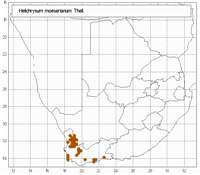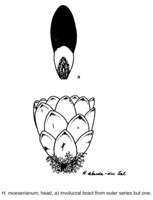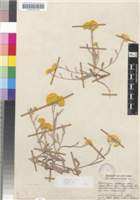Common names:
Sand Sewejaartjie (A)
Diagnostic characters:
Bright sunny-yellow bractsCompact branched inflorescenceMedium sized flowers
Description:
Annual herb mostly 100�300 mm tall, stems erect, solitary or branched from the base, simple or sparingly branched above, greyish-white woolly, distantly leafy. Leaves mostly 15�30 (�60) x 3�5 (�13) mm, diminishing slightly upwards, oblong-spathulate becoming linear upwards, apex obtuse to acute, mucronate, base half-clasping, both surfaces greyish-white woolly. Heads homogamous or heterogamous, campanulate, 3�4 x 2�3 mm, many in terminal corymbose clusters, these often in corymbose panicles. Involucral bracts in c. 5 series, graded, loosely imbricate, outer woolly on the backs, tips subacute or obtuse, inner about equaling or exceeding the flowers, tips opaque canary-yellow, minutely radiating, obtuse, well crisped or only slightly so. Receptacle scarcely honeycombed. Flowers 12�30, (0�) 3�6 female, 12�27 homogamous. Achenes 0.75 mm long, obscurely ribbed, with myxogenic duplex hairs or very rarely glabrous. Pappus bristles many, about equaling corolla, tips barbellate, bases not cohering.
Distribution:
Recorded mainly from the W. and SW. Cape, from Vanrhynsdorp south to the Peninsula, Hex River and Touws River and east to Mossel Bay, on the mountains and on the flats.
Fynbos Biome.
Notes:
Some specimens have more or less acute rather than obtuse outer bracts and there is some variation in the degree of crisping of the inner, obtuse to more or less truncate, bracts; however, H. moeserianum is easily recognized by its annual habit allied to bright yellow crisped bracts. It can be confused with H. versicolor.
Taxonomy:
Literature:
Helichrysum moeserianum Thell. in Vierteljahrsschr. naturf. Ges. Z�rich 66: 239 (1921); Hilliard & Burtt in Bot, J. Linn. Soc. 82: 369 (1981).
Type:
Cape, Touws River, Nov. 1898, Schimper (Z, holo.).
Synonym(s):
Gnaphalium bracteatum Lam., Encycl. 2: 751 (1788), non Helichrysum bracteatum Andr. (1805). Type: Cape of Good Hope (P-LAM).
Helichrysum rutilans sensu Less., Syn. Comp. 275 (1832); DC., Prodr. 6: 185 (1838); Harv. in F.C. 3: 234 (1865); Moeser in Bot. Jb. 44: 287 (1910); Levyns in Adamson & Salter, Fl. Cape Penins. 781 (1950), non (L.) D. Don.
Vouchers:
Acocks 17562 (PRE); Compton 21740 (NBG); Nordenstam & Lundgren 1508 (E, S); Pillans 7980 (BOL); Schlechter 8362 (BM; E; G; PRE); Tyson 706 (E; SAM).


_sml.jpg)
_sml.jpg)
_sml.jpg)
_sml.jpg)
